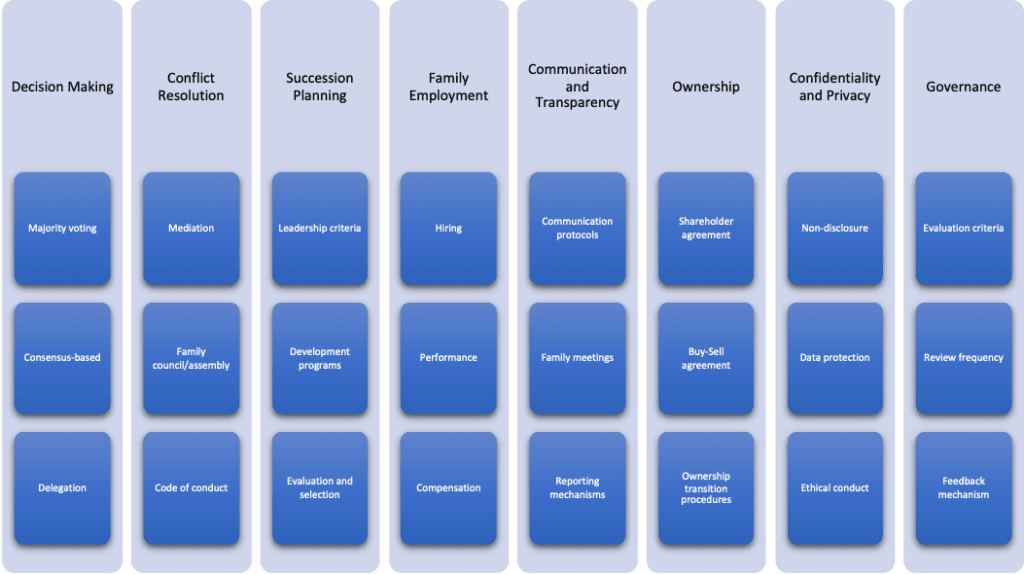Family-owned businesses face unique challenges due to the intersection of family dynamics and business operations. To effectively manage these complexities, implementing well-defined policies and procedures is crucial. This article explores different types of policies and procedures that can be implemented as part of the family governance structure in a family-owned business. These policies and procedures cover areas such as decision-making, conflict resolution, succession planning, and maintaining family harmony, and is summarised in Fig 1: Policy and Procedure Chart.
Fig 1: Policy and Procedure Chart
Decision-Making Policies:
Clear decision-making policies provide a structured approach to decision-making within the family-owned business. These policies may include:
a. Majority voting: Establishing voting rights and procedures for important decisions, ensuring fair representation.
b. Consensus-based decision-making: Promoting open dialogue and seeking consensus among family members.
c. Delegated authority: Assigning decision-making authority to specific individuals or committees based on their expertise and roles.
2. Conflict Resolution Procedures:
Conflict is inevitable in any organisation, especially within a family-owned business. Implementing effective conflict resolution procedures helps manage conflicts constructively. Consider the following approaches:
a. Mediation: Engaging a neutral third party to facilitate dialogue and find mutually acceptable solutions.
b. Family council or assembly: Establishing a platform for open discussion and collaborative problem-solving.
c. Codes of conduct: Outlining acceptable behaviour, conflict resolution methods, and consequences for non-compliance.
3. Succession Planning Policies:
Succession planning ensures a smooth transition of leadership from one generation to the next. Implement policies and procedures to facilitate this process:
a. Leadership criteria: Defining the qualities, skills, and experience required for leadership roles.
b. Development programs: Providing training and mentoring to prepare potential successors for their future roles.
c. Evaluation and selection process: Establishing a fair and transparent process for selecting successors based on merit and alignment with the family’s vision.
4. Family Employment Policies:
Managing family members’ employment within the business requires clear policies to ensure fairness, professionalism, and the alignment of skills. Consider:
a. Hiring criteria: Establishing qualifications and requirements for family members seeking employment.
b. Performance evaluation: Implementing objective performance assessment processes for family employees.
c. Compensation and benefits: Establishing fair and consistent policies for family member remuneration and benefits.
5. Communication and Transparency Guidelines:
Transparent communication is essential for maintaining trust and alignment among family members and stakeholders. Develop policies and procedures that foster open communication:
a. Communication protocols: Establishing channels and frequencies for sharing important business information with family members.
b. Family meetings: Outlining the purpose, structure, and frequency of family meetings to discuss business matters and foster collaboration.
c. Reporting mechanisms: Defining regular reporting requirements to keep family members informed about business performance, strategy, and significant events.
6. Ownership Policies and Procedures:
Ownership policies and procedures govern the rights, responsibilities, and transfer of ownership within the family-owned business. Consider the following:
a. Shareholder agreements: Defining the rights and obligations of shareholders, including dividend policies and decision-making authority.
b. Buy-sell agreements: Establishing protocols for buying and selling shares among family members.
c. Ownership transition procedures: Outlining the process and criteria for transferring ownership to the next generation or external parties.
7. Confidentiality and Privacy Policies:
Maintaining confidentiality and privacy is crucial to protect the family and business interests. Develop policies and procedures that safeguard sensitive information:
a. Non-disclosure agreements: Requiring family members and employees to sign agreements to protect confidential information.
b. Data protection: Implementing measures to secure data and comply with relevant privacy regulations.
c. Ethical conduct: Emphasising the importance of confidentiality and privacy in the family’s code of conduct, ensuring that all family members adhere to these principles.
8. Governance Review and Evaluation:
Regular review and evaluation of the family governance structure is essential to ensure its effectiveness and adaptability. Establish policies and procedures for governance review, including:
a. Evaluation criteria: Identifying key performance indicators and benchmarks to assess the effectiveness of governance policies and procedures.
b. Review frequency: Determining the appropriate intervals for reviewing the governance structure and making necessary adjustments.
c. Feedback mechanisms: Seeking feedback from family members, board members, and external advisors to gather insights for improvement.
Conclusion:
Implementing well-defined policies and procedures is crucial for effective family governance in a family-owned business. By establishing these types of policies, and other guidelines, families can navigate the unique
challenges of combining family dynamics with business operations. These policies and procedures contribute to maintaining family harmony, ensuring a smooth transition of leadership, promoting professionalism, and safeguarding the long-term success of the family-owned business. Regular review and adaptation of these policies and procedures are vital to address changing needs and dynamics within the family and the business. With a strong governance structure in place, family-owned businesses can thrive across generations while preserving their core values and vision.

